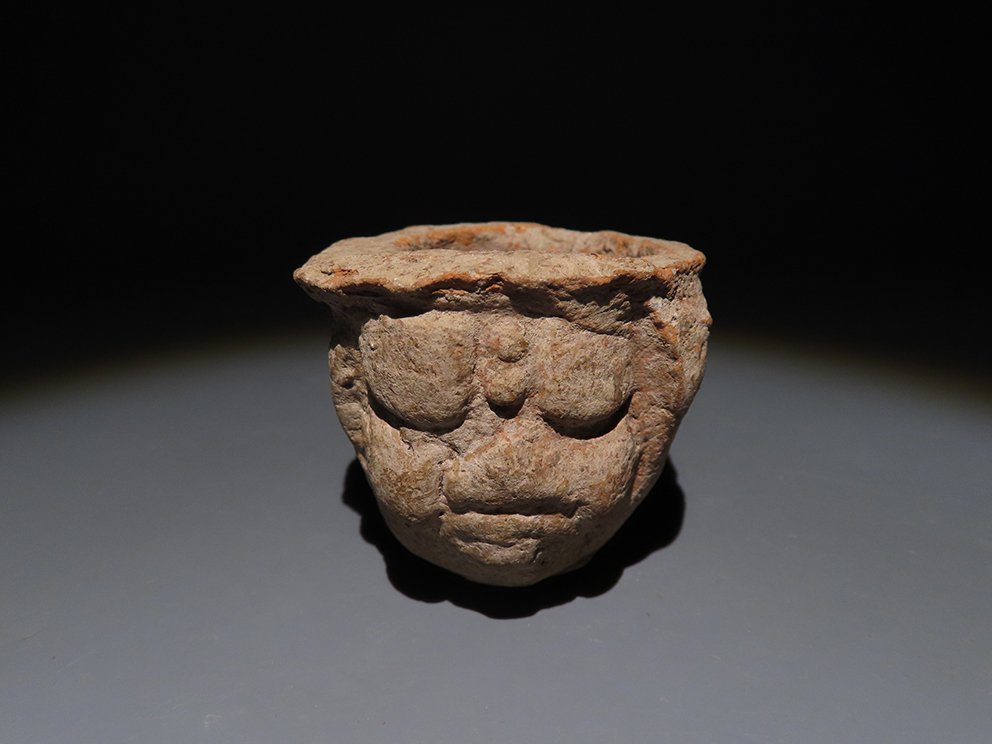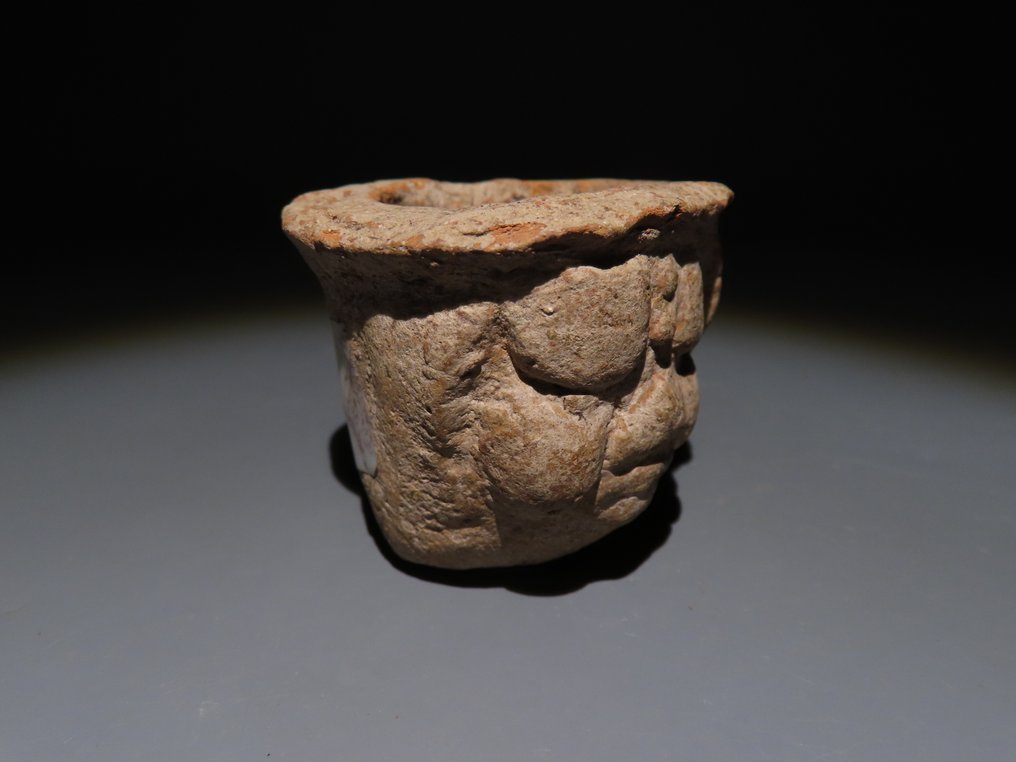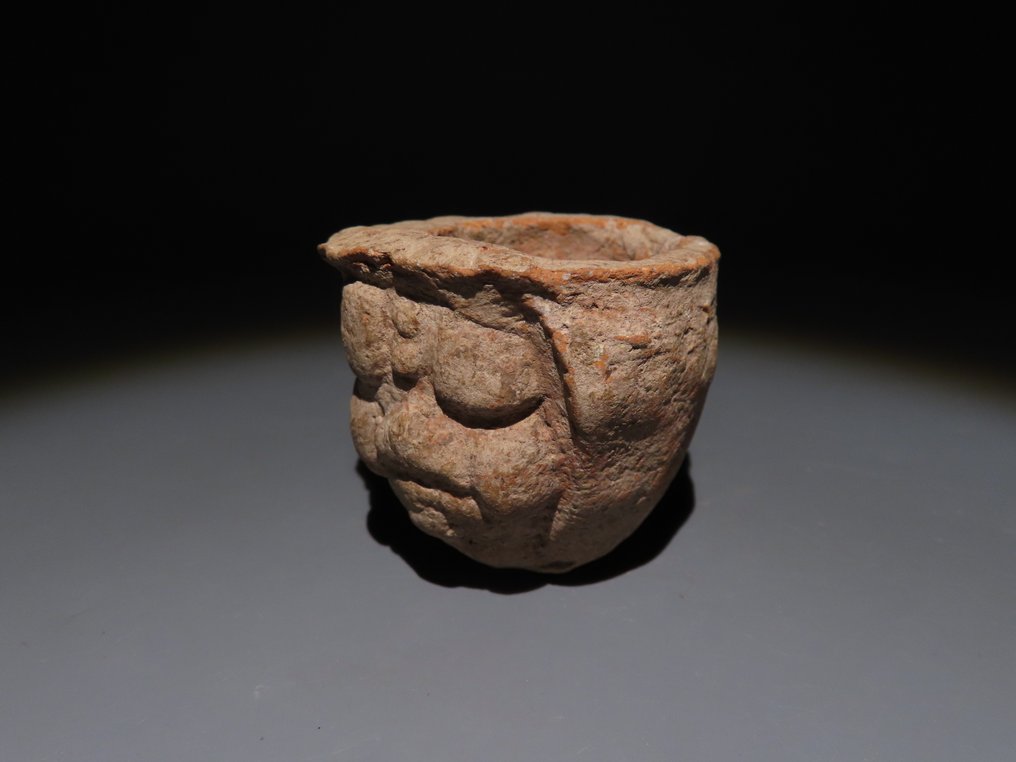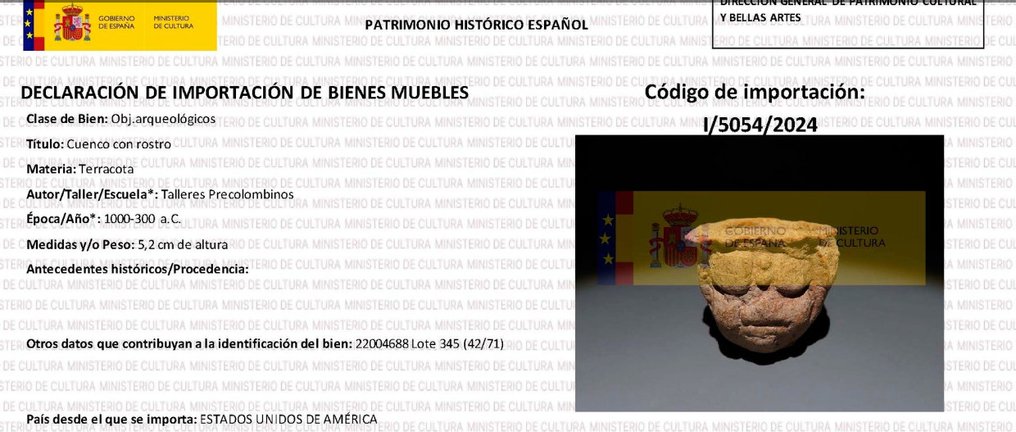Très bien emballé, conforme à la commande.
Se översättningOlmeca, Mexiko Terrakotta Fartyg i form av ett huvud. 1000-300 f.Kr. 5,2 cm höjd. Spansk exportlicens.
Nr 91455883




Vessel in the shape of a head.
Olmeca, Mexico, 1000-300 BC.
Terracotta.
5.2 cm Height.
PROVENANCE: Private collection Donald Wonder (1938 - 2023), California, United States of America.
Acquired between 1981 and 1998 in different establishments such as:
- Harmer Rooke Galleries, New York, United States of America.
- Laurent Bermundez Primitive Arts, Berkeley, California, United States of America.
- Mark Clark, San Francisco, California, United States of America.
CONDITION: Good condition.
DESCRIPTION:
The Olmec culture developed in the Mexican states of Veracruz and Tabasco, a territory bordered by the Gulf of Mexico and the southern highlands of the country. This area is characterised by its high humidity, with rivers, lagoons and large expanses of swamps. It is covered with lush tropical rainforest, populated by animals such as jaguars, tapirs, wild boars and monkeys. At the height of its splendour, the influence of this culture spread throughout Mesoamerica.
The characteristics of the facial features of the stone figures, certain decorative styles and even some symbols and ideograms have led to think of a possible Asian origin of the Olmecs. However, most researchers think of origins from nearby populations in the highlands of Oaxaca, the state of Morelos, southern Veracruz or northern Tabasco. Olmec influence can be observed in almost all of Mesoamerica, especially in societies that inhabited the same period, implying a fluid exchange of both resources and aesthetic concepts. Olmec was undoubtedly the most influential culture in the entire cultural development of Mesoamerica, as it laid both aesthetic and ideological foundations that were used and reused by later societies, even up to Hispanic times.
One of the best known Olmec artistic manifestations is the stone statuary. The monumental stone heads and the ceramic figures known as ‘baby faces’ stand out above all. Both types of work demonstrate great artistry, as well as establishing certain key points in the style of art that characterises this culture: a combination of sinuous and straight lines, almond-shaped, slit-eyed faces with flat noses and open nostrils. In some cases the mouths have deformities similar to a ‘harelip’ or take on feline features, such as a jaguar's snout. The most commonly used techniques for finishing the ceramics were polishing, bas-relief and over-relief or incising, which was often highlighted with red or white pigments. They also achieved remarkable mastery in the mural painting that adorns the walls of some buildings, probably for ritual use. The figures, mainly human representations, were drawn with the face in profile and the body from the front, often holding objects in their hands and surrounded by symbols of all kinds.
Notes:
- The piece includes authenticity certificate.
- The piece includes Spanish Export License (Passport for European Union) - If the piece is destined outside the European Union a substitution of the export permit should be requested, can take between 1-2 weeks maximum.
- The seller guarantees that he acquired this piece according to all national and international laws related to the ownership of cultural property. Provenance statement seen by Catawiki.
Säljarens berättelse
Vessel in the shape of a head.
Olmeca, Mexico, 1000-300 BC.
Terracotta.
5.2 cm Height.
PROVENANCE: Private collection Donald Wonder (1938 - 2023), California, United States of America.
Acquired between 1981 and 1998 in different establishments such as:
- Harmer Rooke Galleries, New York, United States of America.
- Laurent Bermundez Primitive Arts, Berkeley, California, United States of America.
- Mark Clark, San Francisco, California, United States of America.
CONDITION: Good condition.
DESCRIPTION:
The Olmec culture developed in the Mexican states of Veracruz and Tabasco, a territory bordered by the Gulf of Mexico and the southern highlands of the country. This area is characterised by its high humidity, with rivers, lagoons and large expanses of swamps. It is covered with lush tropical rainforest, populated by animals such as jaguars, tapirs, wild boars and monkeys. At the height of its splendour, the influence of this culture spread throughout Mesoamerica.
The characteristics of the facial features of the stone figures, certain decorative styles and even some symbols and ideograms have led to think of a possible Asian origin of the Olmecs. However, most researchers think of origins from nearby populations in the highlands of Oaxaca, the state of Morelos, southern Veracruz or northern Tabasco. Olmec influence can be observed in almost all of Mesoamerica, especially in societies that inhabited the same period, implying a fluid exchange of both resources and aesthetic concepts. Olmec was undoubtedly the most influential culture in the entire cultural development of Mesoamerica, as it laid both aesthetic and ideological foundations that were used and reused by later societies, even up to Hispanic times.
One of the best known Olmec artistic manifestations is the stone statuary. The monumental stone heads and the ceramic figures known as ‘baby faces’ stand out above all. Both types of work demonstrate great artistry, as well as establishing certain key points in the style of art that characterises this culture: a combination of sinuous and straight lines, almond-shaped, slit-eyed faces with flat noses and open nostrils. In some cases the mouths have deformities similar to a ‘harelip’ or take on feline features, such as a jaguar's snout. The most commonly used techniques for finishing the ceramics were polishing, bas-relief and over-relief or incising, which was often highlighted with red or white pigments. They also achieved remarkable mastery in the mural painting that adorns the walls of some buildings, probably for ritual use. The figures, mainly human representations, were drawn with the face in profile and the body from the front, often holding objects in their hands and surrounded by symbols of all kinds.
Notes:
- The piece includes authenticity certificate.
- The piece includes Spanish Export License (Passport for European Union) - If the piece is destined outside the European Union a substitution of the export permit should be requested, can take between 1-2 weeks maximum.
- The seller guarantees that he acquired this piece according to all national and international laws related to the ownership of cultural property. Provenance statement seen by Catawiki.
Säljarens berättelse
- 777
- 8
- 3
Very nice oil lamp in good condition corresponding to the pictures.
Se översättningIntaglio wie beschrieben und mit guter Dokumentation: Echtheitszertifikat und spanische Ausfuhrgenehmigung liegen dabei. Sehr seriös. Gerne wieder.
Se översättningGreat packing, good description, very happy
Se översättningSehr schön und wie beschrieben. Immer wieder gerne.
Se översättningBeautiful item Fast and safe shipping Recommended seller
Se översättningGreat as always. Thank you.
Se översättningtop 💯💯💯💯💯 come sempre :-)
Se översättningTrès bel objet, envoi rapide et soigné, vendeur recommandé
Se översättningExcelente como siempre, garantía total y rapidez en el envio. Gracias.
Se översättningExcellent service and beautiful piece, thank you very much.
Se översättningtrès belle piece merci
Se översättningbien arrivé, bien emballé, correspond à l'image. vendeur pro
Se översättningMerci! beaucoup de plaisir à la decouverte du pendentif ! Envoi rapide et emballage soigné
Se översättningPreciosa terracota y un molde de ojo udjat de una conocida colección. Como siempre mucha profesionalidad y garantía en el vendedor.
Se översättningAlles bestens , vielen Dank !! Gracias por la transacción sin problemas.
Se översättningTop vendeur professionnel 👍
Se översättningTodo perfecto 👌 gracias al equipo de Bagot.
Se översättningTot correcte+++ Moltes gràcies!!
Se översättningGreat
Se översättningSo beautiful!thank you very much!perfect!
Se översättningGreat
Se översättningGreat!!
Se översättningTutto bene PERFETTO ++++++
Se översättningOggetto delizioso
Se översättning- 777
- 8
- 3
Très bien emballé, conforme à la commande.
Se översättningAnsvarsfriskrivning
Säljaren garanterar och kan bevisa att objektet införskaffats på lagligt sätt. Säljaren har informerats av Catawiki att de måste lämna den dokumentation som är obligatorisk enligt lagar och regler i det land de är bosatta. Säljaren garanterar och har rätt att sälja/exportera detta objekt. Säljaren tillhandahåller all information om härkomst som är känd om objektet till köparen. Säljaren säkerställer att alla nödvändiga tillstånd är/kommer att bli ordnade. Säljaren informerar köparen omedelbart om eventuella förseningar gällande att anskaffa sådana tillstånd.
Säljaren garanterar och kan bevisa att objektet införskaffats på lagligt sätt. Säljaren har informerats av Catawiki att de måste lämna den dokumentation som är obligatorisk enligt lagar och regler i det land de är bosatta. Säljaren garanterar och har rätt att sälja/exportera detta objekt. Säljaren tillhandahåller all information om härkomst som är känd om objektet till köparen. Säljaren säkerställer att alla nödvändiga tillstånd är/kommer att bli ordnade. Säljaren informerar köparen omedelbart om eventuella förseningar gällande att anskaffa sådana tillstånd.